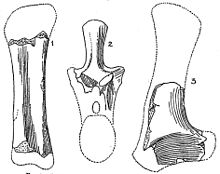Algoasaurus
| Algoasaurus | |
|---|---|

| |
| Femur, vertebra and scapula (holotype) | |
| Scientific classification | |
| Domain: | Eukaryota |
| Kingdom: | Animalia |
| Phylum: | Chordata |
| Clade: | Dinosauria |
| Clade: | Saurischia |
| Clade: | †Sauropodomorpha |
| Clade: | †Sauropoda |
| Clade: | †Neosauropoda |
| Genus: | †Algoasaurus Broom, 1904 |
| Species: | †A. bauri
|
| Binomial name | |
| †Algoasaurus bauri Broom, 1904
| |
Algoasaurus (
Discovery and naming
The holotype, a cervical
The type species, A. bauri, was named by Robert Broom in 1904 and he likened Algoasaurus to Brontosaurus and Diplodocus.[1] Broom gave much of his fossil collection to the American Museum of Natural History in 1913, including the ungual phalanx from the holotype, listed as specimen AMNH FR 5631.[2]
Canudo & Salgado (2003) and Ibiricu et al. (2012) both considered Algoasaurus to have belonged to
Description
The animal may have been around 9 m (30 ft) long when it died,[6] although this can not be confirmed as the holotype is very fragmentary. Before it was lost, the femur was estimated to have been up to 50 centimetres (20 in) when complete.[1]
Classification
Algoasaurus was a
Paleoenvironment
Sedimentological analysis of the holotype assemblage suggests it came from a horizon transitioning into a drier climate.[11] Other animals from the Kirkwood Formation include the iguanodontian Iyuku, the stegosaur Paranthodon, the ornithomimosaur Nqwebasaurus, and several other unnamed dinosaurs.
References
- ^ a b c d Broom, R. (1904). On the occurrence of an opisthocoelian dinosaur (Algoasaurus Bauri) in the Cretaceous beds of South Africa. Geological Magazine, decade 5, 1(483):445-447.
- ^ a b Broom, R. (1915). Catalogue of types and figured specimens of fossil vertebrates in the American Museum of Natural History. II.–Permian, Triassic and Jurassic reptiles of South Africa. Bulletin of the American Museum of Natural History 25(2):105–164.
- ^ ISSN 0195-6671.
- ^ a b Canudo, J. I., and L. Salgado. (2003). Los dinosaurios del Neocomiense (Cretácico Inferior) de la Península Ibérica y Gondwana occidental: implicaciones biogeograficas. Pages 251–268 in F. Pérez-Lorente, editor. Dinosaurios y Otros Reptiles Mesozoicos de España. Instituto de Estudios Riojanos, Logroño, Spain.
- ^ a b Ibiricu, L. M., G. A. Casal, M. C. Lamanna, R. D. Martínez, J. D. Harris, and K. J. Lacovara. (2012). The southernmost records of Rebbachisauridae (Sauropoda: Diplodocoidea), from early Late Cretaceous deposits in central Patagonia. Cretaceous Research 34:220–232.
- ISBN 0-679-41770-2.
- ISBN 0-89464-985-X.
- ^ Steel, R. (1970). Saurischia. Handbuch der Paläoherpetologie/Encyclopedia of Paleoherpetology. Part 14. Gustav Fischer Verlag:Stuttgart p. 1-87.
- ISBN 0-520-06727-4.
- ISBN 0-520-24209-2.
- S2CID 250730794.
